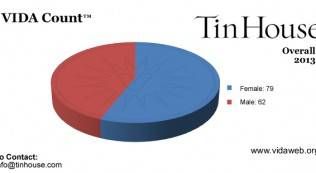
All the Surprises (Both Good and Bad) From This Year’s VIDA Count
I look forward to The VIDA Count every year, which basically boils down to a series of pie charts that show how many men (in red) were represented in the most influential literary journals each year vs. women (in blue). I don’t look forward to it like I look forward to Christmas, because on Christmas I get to hang out with my family and open presents, and on VIDA Count Day I get to see how prejudiced and backwards and resistant to change so many literary journals are. Still there are some awesome pie charts in this year’s round-up. And there are some pie charts that should be so ashamed of themselves. Let’s take a look at some of the best and the worst of the bunch and distribute the praise and blame accordingly.
TIN HOUSE
Confetti and marching bands and two dozen parade floats for Tin House. 79 women represented vs 62 men in 2013. I think sometimes people look at these stats hoping for a fifty-fifty split, but I want to see tons of magazines that skew distinctly in favor of female contributors and subjects. In three out of the four categories considered (book reviewers, bylines, and overall) women took the lead, and the male to female ratio was 12:8 when it came to authors reviewed.
PARIS REVIEW
The Paris Review’s numbers, according to VIDA, had previously been “among the worst in our count,” but this year it looks like those Bad News Bears turned their game around. Fiction and poetry skewed female, essays held even, interviews were male 2:1 and overall numbers skewed female by a single contributor. Most improved is one of the lame awards (everyone in Little League wants MVP, of course they do, being the Most Valuable Anything is rad) but still, an award is better than no award, good job Paris Review.
NEW YORK TIMES BOOK REVIEW
I’m not head over heels in love with these numbers (male authors reviewed outstrip female authors reviewed 482:332, their book reviewers hold a little more even at 412 male reviewers to 393 female reviewers and 1 transgender reviewers), but still, because the publication upped its female reviewers, its overall numbers are much better this year. Not good enough to win Most Improved though, NYTBR, you need to review a shit-ton more women authors to clinch that title.
NEW YORK REVIEW OF BOOKS
Is this a joke, NYRB? You’re about a month early for April Fools. Also, you’re not supposed to do April Fools ALL YEAR LONG. Even after I wrote that very disappointed article about you for Book Riot six months ago, you still refuse to change your ways? Reviewers, authors reviewed, bylines, overall, all your pie charts look the same, which is to say they look like shit. You are a disgrace to pie charts, sirs.
MCSWEENEY’S
This made me genuinely sad. McSweeney’s is supposed to be young and cool, and these numbers are not young and cool, they’re old-white-dudes-yearning-for-a-past-that-sucked-for-everyone-who-wasn’t-white-and-a-dude sad and lame. The Believer’s (another McSweeney’s publication) are better, but they’re not THAT much better. The Believer had an almost equal number of male/female interviewers/interviewees, but blew it hard with book reviewers and authors reviewed. And as a side note, I was incredibly unimpressed with Lucky Peach’s (another McSweeney’s publication) gender issue, for an issue that was supposed to rep women and men equally, that issue short-shrifted women HARD. Unless these numbers turn around, McSweeneys is going to have to resign itself to being as hip as knee britches and powdered wigs.
Did you guys take a look at this year’s pie charts? What are your thoughts/feelings/whateverings?
_________________________
Sign up for our newsletter to have the best of Book Riot delivered straight to your inbox every week. No spam. We promise.
To keep up with Book Riot on a daily basis, follow us on Twitter, like us on Facebook, , and subscribe to the Book Riot podcast in iTunes or via RSS. So much bookish goodness–all day, every day.











